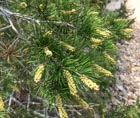Conservation Status

Pinus remota
(Little) Bailey et Hawksworth 1979
Common names
Texas pinyon, paper-shell pinyon, Catarina pine, piñon, nut pine (Perry 1991).
Taxonomic notes
Subsection Cembroides. Syn: Pinus cembroides var. remota Little 1966; P. catarinae M.-F. Robert-Passini 1981. Raising Little's variety to species rank was justified because of the thin-walled seed shells and early loss of fascicle sheaths, two characters that are more clearly expressed in Mexican than Texas populations and that clearly set this taxon apart from the P. cembroides complex (Farjon and Styles 1997). Conversely, P. catarinae is distinguished from P. remota by nothing more than habit; it grows as a shrub rather than an erect tree, a situation evidently due to poor site quality at its type locale (Perry 1991).
Nucleic acid sequencing has elucidated much detail in subsection Cembroides, confirming that P. catarinae is synonymous with P. remota (Gernandt et al. 2003), and that the scattered P. remota populations are monophyletic within a clade sister to the P. johannis group (P. johannis, P. discolor, and P. culminicola) (Montes et al. 2019). Although Little (1968) argued for a possible history of introgressive hybridization between P. remota and P. edulis, molecular evidence does not support this idea (Gernandt et al. 2003, Montes et al. 2019). Conversely, there is evidence of P. remota containing genes introgressed from P. × kohae, a plausible scenario since there is some evidence of Pleistocene contact between the distributions of these taxa (Montes et al. 2019).
Description
Shrubs, or small trees 9 m tall and 40 cm dbh, with a contorted, low-forking trunk of spreading branches. Bark an mature trees thick, rough, scaly, exfoliating in thin scaly plates, or longitudinally furrowed; dark gray. Twigs rough with prominent, non-decurrent pulvini, which leave circular scars after fascicles have fallen. Cataphylls 5 mm long, subulate, reflexed, gray. Vegetative buds ovoid-cylindric, terminal bud 5-7 mm long, acute, not or slightly resinous. Fascicle sheaths initially 5 mm long, soon caducous, not recoiling to form a rosette. Leaves in fascicles of 2(-3), persisting 4-5 years, slightly curved to falcate, stiff, (2-)3-4.5(-5.5) cm long, 0.8-1.1 mm thick; apex acute-acuminate; abaxial face dull light green or yellowish green; adaxial face(s) slightly glaucous; stomata on all faces of the leaves. Pollen cones ovoid, 4-5 mm long, pink or purplish, maturing light yellow. Seed cones solitary or in pairs on 5-8 mm long, slender, curved peduncles, maturing in two years. Mature cones subglobose, (2-)2.5-4 × 3-6 cm when open. Seed scales opening widely, loosely attached to the rachis, irregularly shaped, with incurved margins and 1-2 deep seed cavities. Apophysis prominently raised, transversely or radially keeled, irregularly rhombic to pentagonal in outline; upper margin angular and irregular; color (lustrous) light brown to reddish brown. Umbo dorsal, flat or indented, with a minute, deciduous prickle. Seeds obovoid-angular, 12-16 mm long, light reddish brown with a grey tinge; integument very thin, 0.1-0.4 mm; endosperm white. Seed wings vestigial, remnants remain on the scale when the seeds are dispersed (Farjon 2010).
Distribution and Ecology
USA: Texas, on the Edwards Plateau and in the extreme W along the Rio Grande; and Mexico: Chihuahua, Coahuila and extreme western Nuevo León. The populations are all disjunct, found in isolated mountain ranges (a situation that certainly implies this species was more widespread during periods of reduced temperature and increased moisture availability, such as during the late Pleistocene). Although found at 450 m elevation at the type locale on the Edwards Plateau, in Mexico it occurs at 1200-1850 m elevation, often on calcareous substrates, on particularly dry sites where it may assume shrub habit. As such, it is a typical piñon of the cold Chihuahuan desert, typically occurring with Juniperus monosperma or Juniperus ashei, species of Quercus and Cercocarpus, and occasionally Pinus cembroides or Pinus stormiae (Farjon and Styles 1997). Hardy to Zone 8 (cold hardiness limit between -12.1°C and -6.7°C) (Bannister and Neuner 2001).
Pines of the Pinus cembroides complex. Gold is P. remota. Purple diamonds are P. cembroides ssp. cembroides, purple stars are P. cembroides ssp. orizabensis, green is P. culminicola, blue is P. discolor, brown is P. johannis, and red is P. lagunae. Based on GBIF.org downloads https://doi.org/10.15468/dl.pfuj4k (P. culminicola), https://doi.org/10.15468/dl.vvju45 (P. remota), and https://doi.org/10.15468/dl.5k7x9y (all other taxa), accessed 2023.03.09, with location uncertainty <10 km, and location duplicates removed.
This species' extent of occurrence and area of occupancy are large; in the absence of any evidence of significant past, recent or ongoing decline, its conservation status is "Least Concern" (Farjon 2013).
Remarkable Specimens
No data as of 2023.03.10.
Ethnobotany
P. remota sees limited use due to its scattered occurrence in often remote places. The edible seeds are harvested and sold incidental to harvest of other, more abundant piñons.
Observations
See the observations on iNaturalist, many of which are in readily-accessible locations.
Remarks
The epithet "remota" refers to the distance between fascicles along the twig.
Citations
Bailey, D. K. and F. G. Hawksworth. 1979. Pinyons of the Chihuahuan Desert region. Phytologia 44:129-133. Available: www.biodiversitylibrary.org/item/47046, accessed 2014.03.25.
Farjon, Aljos. 2010. A Handbook of the World's Conifers. Leiden, Netherlands: Brill Academic Publishers.
Farjon, Aljos. 2013. Pinus remota. The IUCN Red List of Threatened Species 2013: e.T42409A2978032. https://dx.doi.org/10.2305/IUCN.UK.2013-1.RLTS.T42409A2978032.en, accessed 2023.01.08.
Gernandt, D. S., A. Liston, and D. Piñero. 2003. Phylogenetics of Pinus subsections Cembroides and Nelsoniae inferred from cpDNA sequences. Systematic Botany 28:657–673.
Little, E. L. 1968. Two new pinyon varieties from Arizona. Phytologia 17:329–342.
Montes, J. R., P. Peláez, A. Willyard, A. Moreno-Letelier, D. Piñero, and D. S. Gernandt. 2019. Phylogenetics of Pinus Subsection Cembroides Engelm. (Pinaceae) Inferred from Low-Copy Nuclear Gene Sequences. Systematic Botany 44(3):501–518.
See also







